

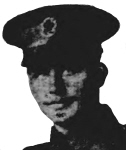
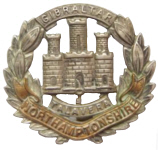
No.27051, Private, Walter Henry TILLETT
Aged 27

|
Walter Henry Tillett was born in Woolpit (Stow Q1-1891 4A:787), son of Charles and Thirza Minnie TILLETT (née LAUGHLIN).
1891 census...Aged 1, he was at Cottage, Mill Lane, Woolpit with his father Charles TILLETT [33] farm labourer born Barwell; his mother Thirza [24]; sisters Thirza [6] and Rose E [2]; brother Charles E.[5]. All except his father were born in Woolpit. 1901 census...Aged 11, he was at Broom Hills, Woolpit with his parents(father now a miller's carter); sisters Rose, Florence [8], Winifred [3] and Nellie [1]; brothers Charles (shepherd's page) and Philip [5]; grandfather Thomas LAUGHLIN [75] widower, brickyard labourer born Elmswell. The new siblings all born in Woolpit 1911 census...Aged 21, a farm labourer, he was at Hengrave with his parents(father now horsekeeper),with his brother Philip (farm labourer); sisters Winifred, Alice {Nellie}, Maid [9] Catherine [7] and Queenie [4] and a cousin Reginald [4]. The newcomers were all born in Woolpit, but there is no clue as to parentage of Reginald. brother Charles was a private in the Suffolk Regiment, at Mustafa Pasha Barracks, Alexandria, Egypt. All 11 siblings survive. His father's address later was Hollow Rd., Fornham St. Martin, Bury St. Edmund's. His elder brother Charles died in France in 1915. see here |

| He enlisted in Bury St Edmunds in 1909 in the Notts and Derby (Sherwood Foresters) Regiment Special Reserves. Special Reserve
The Special Reserve provided a form of part-time military service. It was introduced in 1908 as a means of building up a pool of trained reservists in addition to those of the regular Army Reserve. Special Reservists enlisted for 6 years and had to accept the possibility of being called up in the event of a general mobilisation and to undergo all the same conditions as men of the Army Reserve. This differed from the Territorial Force in that the men could be sent overseas. Their period as a Special Reservist started with six months full-time preliminary training (paid the same as a regular) and they had 3-4 weeks training per year thereafter. Walter attested at Bury St Edmunds on 8th March 1909 in the Nottinghamshire and Derby Regiment (Sherwood Foresters) Special Reserves. He gave his age as 19 years 3 months, born Woolpit, weighing 116 lbs(52.8 kg), 5 feet 5.5 inches (166.4 cm)tall, chest 35" to 38" (88.9 to 96.5 cm), blue eyes, brown hair, Church of England. Later forms have his next of kin as parents at Eastgate, Bury St Edmunds and brother Charles, in the Army in Malta. He underwent full time training from 8th March to 7th August 1909 with 3rd Battalion Sherwood Foresters. Mobilised on the outbreak of war on 5th August 1914, he joined the BEF in France on the 11th November 1914. He received a gun shot wound to the head on he 8th August 1915 and was admitted to 18 Field Ambulance and then transferred to 25 Stationary Hospital, Etaples on 18th, thence to Convalescence Camp on 27th before returning to his unit on 27th September 1915. On 22nd February 1916 he reported to Rouen ready for shipping home for discharge, arriving 23rd February and being discharged on 10th March 1916 having served his time. He was now 5 feet 6 inches tall, chest 39" to 41". he gave his intended address as Hengrave Mill. Whether he enlisted again or was conscripted is not clear, but he must very soon have joined the Nottinghamshire Regiment and shipped back to France, where he was last seen on 3rd May 1917 during the 2nd Battle of Arras. The battalion war diary has :- "3.5.17 - 12:30 am - Battalion left NEUVILLE VITASSE by companies. 1st company at 12:30, remaining at 5 minutes intervals, and marched to trenches at N:29.c. (map 51 SW) Zero hour was 3:35 am. The Battalion was not engaged in the first part of the operations. After retirement form positions W of CHERISY and FONTAINE-CROISILLE the battalion was ordered to counter attack and occupy FONTAINE TRENCH from O.32.a.5.3. to O.26.c.2.0. (see image below) and the circular trench in rear of it. Orders had been received that the bombardment would start at 5:30 pm for half and hour and then a pause for a quarter of an hour and the rolling barrage would open at 6:16 pm. 200 yards in front of our trench, but this was later postponed for one hour. Battalion was in position at 5:30 (all in front line trench) with the LEICESTERSHIRE REGIMENT (110 Infantry Brigade) on the right and the 7th QUEENS (55th Brigade) on the left. These battalions were to attack simultaneously after a preliminary bombardment, as stated. The rolling barrage opened the the battalion attacked with two companies. 2 platoons in the front line and 2 platoons 2nd line. "A" and "D" companies were in support. Of the attacking companies, "B" company under Captain Mobbs were on the right and "C" company under Captain Shepherd on the left. "A" company were on the right and "D" company on the left as supporting companies. "D" company furnished a bombing party (1 N.C.O. and 8 men) who advanced downCABLE TRENCH with the leading wave of the assaulting company. They also furnished carrying parties for bombs and S.A.A.[small arms ammunition] for "C" company, down CABLE TRENCH running towards CHERISY from O.31.b.4.9. "B" and "C" companies advanced as close to the barrage as possible, having several casualties from the barrage. The hostile machine gun fire which swept the area they had to cross was as bad as in the attack in the morning. "B" company (right assaulting company) having 50% casualties by the time they reached within 50 yards of the enemy wire- having covered nearly 900 yards. The found the wire intact, the bombardment not having touched it, and the machine gun fore from the right flank as well as from the front rendered further advance impossible. "C" Company (left assaulting company) were able to get down CABLE TRENCH owing to the Stokes gun having totally cleared the trench of enemy. They started over the top but found machine gun fire rendered further advance in that way impossible. They pushed their way by bombs and rifle grenades down CABLE TRENCH to the junction of FONTAINE TRENCH, and worked their way along that trench for about 70 yards. After a severe bombing and grenade fight, where several enemy were killed, this company, finding its flanks in danger, was compelled to get back to the original front line. No blame can be attached to the Company Commander,on the contrary he personally and the officers of the whole company put up a very big fight. The right company were then ordered to withdraw to the original front line - one of the objects of this attack was to enable wounded men and others who were lying out since morning to get back. A considerable number of men did so. No of casualties 120 including 6 officers - lack of success in this operation due to intensive machine gun fire. CWGC have 39 killed, none with an identified grave. The Bury Free Press of 21st July 1917 reported:- FORNHAM ST.MARTIN SOLDIER AMONG THE MISSING We understand that Mr. and Mrs. Tillett of Hollow Road, Fordnham St.Martin have been officially informed that their son, Prvt W.Tillett of C Coy, 6th Northamptonshire Regiment has been recorded as missing since May 3rd last. We are publishing a photograph of Prvt Tillett (above) .................and the parents hoped for some news from comrades. Unusually he has two medal index cards, one from the Sherwood Foresters with the 1914 Star which, although recognising his early service, does not have the clasp which was probably due to it not being claimed. That from the Northamptonshire regiment does not have the Star, just possibly not aware of his previous service |
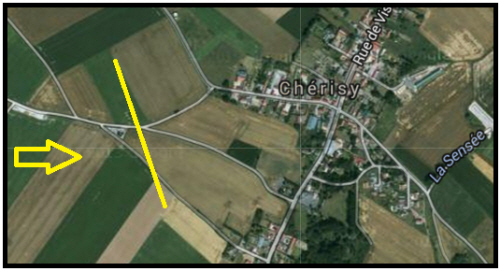
trench O.32.a.5.3 to O.26.c.2.0. mentioned above
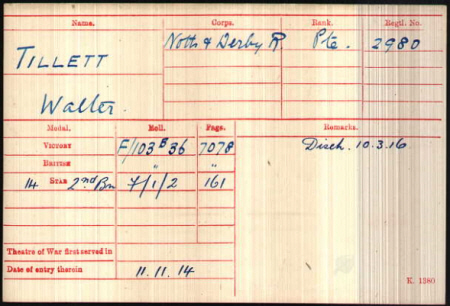
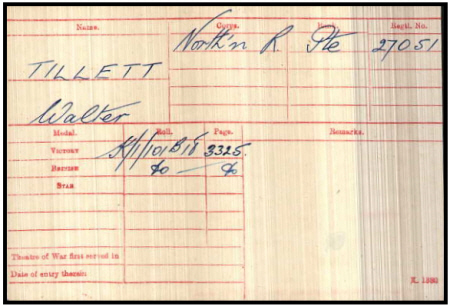
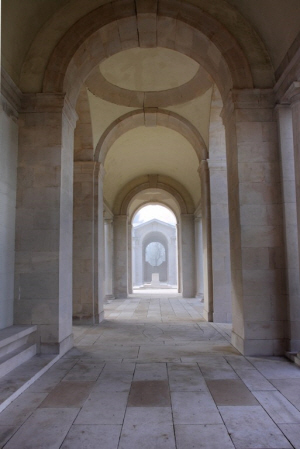
photo: Commonwealth War Graves Commission
click here to go to the Commonwealth War Graves Commission website for full cemetery/memorial details